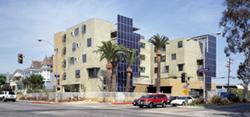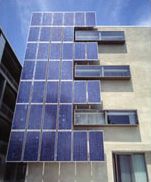25 May 2003
Green, Low-Income Housing in Santa Monica
Colorado Court is a 5-story, 44 unit single room occupancy apartment complex for low income tenants in Santa Monica. It is also one of the first buildings of its kind in the United States that is 100% energy independent, generating nearly all its own energy for electricity, heat and light.
Architectural Review, November 1, 2002:
 “In both siting and form, the building has been designed to exploit passive environmental control strategies such as natural ventilation, maximizing daylight and shading south-facing windows. But it also incorporates a number of innovative energy generation measures, notably a natural gas-powered turbinecum-heat recovery system that generates the base electrical load and services the building’s hot water needs. Photovoltaic panels set in the walls and roof supply most of the peak-load energy demand. This co-generation system converts natural gas into electricity to meet the building’s power needs. The same system also captures and uses waste heat to produce hot water and space heating for residents throughout the year. Unused energy from the photovoltaic panels is returned to the grid during the day and retrieved at night as needed. The architects estimate that these energy generation and conservation systems will pay for themselves in less than 10 years and annual savings in electricity and natural gas bills should average around $6000....
“In both siting and form, the building has been designed to exploit passive environmental control strategies such as natural ventilation, maximizing daylight and shading south-facing windows. But it also incorporates a number of innovative energy generation measures, notably a natural gas-powered turbinecum-heat recovery system that generates the base electrical load and services the building’s hot water needs. Photovoltaic panels set in the walls and roof supply most of the peak-load energy demand. This co-generation system converts natural gas into electricity to meet the building’s power needs. The same system also captures and uses waste heat to produce hot water and space heating for residents throughout the year. Unused energy from the photovoltaic panels is returned to the grid during the day and retrieved at night as needed. The architects estimate that these energy generation and conservation systems will pay for themselves in less than 10 years and annual savings in electricity and natural gas bills should average around $6000....
Details such as fluorescent lights which automatically extinguish when a room is not in use, insulation made from recycled newspapers, a bike store, CFC-free refrigerators and a trash recycling room reinforce the evangelical message. As many of the technologies are relatively unproven, it is hoped that in its intelligent exploration of the potential of sustainability, the building will act as a successful demonstration project for developers, planners, politicians, architects and, most especially, the wider public.”
The apartments themselves are 375 square feet studios with a kitchenette and a small bathroom. Shared areas include a lounge, laundry, and courtyard.
The project falls under Santa Monica’s “Sustainable City Program” which tries to reduce electricity and water consumption, and install photovoltaic cells on in public and private projects.
Los Angeles Times, June 26, 2001:
“A host of public and private entities—including the cities of Santa Monica and Irvine, Southern California Edison and the California Energy Coalition—are involved in planning, funding and monitoring the innovative building. The two cities, the conservation group and the utility have formed a group known as Regional Energy Efficiency Initiative, which has contributed about $250,000 to energy-saving devices in the building. In addition, Santa Monica itself is contributing about $250,000 toward electricity generators.
The building will be loaded with energy-saving and environmentally benign or ‘sustainable’ devices. Heat from the micro-turbine will produce hot water, eliminating the need for a conventional water heater....
 Prevailing breezes will cool the building, which will have no mechanical air conditioners. The U-shaped structure ‘acts like a giant wind scoop,’ said architect Larry Scarpa, a principal of Santa Monica-based Pugh & Scarpa.
Prevailing breezes will cool the building, which will have no mechanical air conditioners. The U-shaped structure ‘acts like a giant wind scoop,’ said architect Larry Scarpa, a principal of Santa Monica-based Pugh & Scarpa.
In yet another ‘green’ flourish, the building will collect all the rainwater from the alley behind the property and funnel it into a series of underground chambers. The water will slowly percolate back into the soil, which will filter the pollutants from the water while preventing contaminated water from spilling into Santa Monica Bay. The drainage system was paid for separately by the city of Santa Monica.
The concept of a building that would be energy self-sufficient emerged about two years ago, when Santa Monica officials met with members of the California Energy Coalition. The city’s Housing Division, which funds construction of low-income housing, chose to make a low-income housing project into a dream project of ‘green’ construction, and Colorado Court became the target.
‘We needed a demonstration project because a lot of developers feel that the technologies are unproven,’ Raida said.
 A number of apartment buildings in Santa Monica and Irvine are to be equipped with energy-saving technology by the Regional Energy Efficiency Initiative, but the Santa Monica building is the only project attempting to provide its own power as well.
A number of apartment buildings in Santa Monica and Irvine are to be equipped with energy-saving technology by the Regional Energy Efficiency Initiative, but the Santa Monica building is the only project attempting to provide its own power as well.
Rebates from the state Energy Commission helped defray the high cost of the energy-generating equipment. The state’s rebate on the solar panels, which cost about $225,000, will be about $62,000. The $57,000 micro-turbine and heat exchanger will yield a $15,000 rebate from Southern California Gas Co.
If recent research and development has yielded new ways of conserving energy and producing electricity, regulations and building codes have not kept pace.
In one instance, architects had to obtain special permission from the city to hang solar panels outside the exterior stairwells because building inspectors said the solar panels ‘enclosed’ the stairwells and triggered requirements for floors, ceilings and fire-rated walls.”
Santa Monica Mirror, December 6-12, 2000:
“[Architects] Pugh Scarpa Kodama and the Community Corporation have been working with the City of Santa Monica and Southern California Edison to come up with an ‘incentive-type’ plan, which would allot a certain amount of energy to each resident per month, and would award those who did not use the full amount with rebates on their energy bills....
Colorado Court’s units will rent for between $316 and $365. They will be available to low-income residents culled from the Community Corp’s waiting list, who meet the low-income requirements for this building. Twenty-two units will be rented to people making less than $12,775 yearly, another 22 to those making less than $14,600 yearly (these figures are based on 35 - 40% of the current median income of $36,500). According to Raida, the typical demographic for a building such as Colorado Court would include full time workers earning minimum wage, and people on fixed incomes such as retirees and the disabled.
The Community Corp’s waiting list currently numbers over 1,000 people.”
It’s great that the org’s and the city could pull together $5.8 million to build high-tech, green, low-income housing. But, experimenting on the poor for their demonstration project? Is this the flip side of environmental racism? Get some low-income tenants to live inside your the unproven technology? No air conditioning in Southern California? An experimental powerplant in the basement, and less-than-fire-rated exterior walls... that cover a fire exit? Evangelical indeed.

